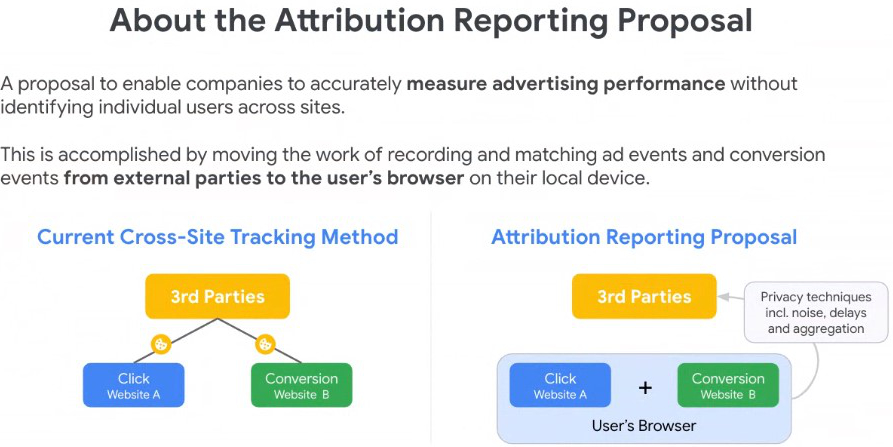Google have recently provided a number updates on their key Privacy Sandbox proposals (e.g. FLEDGE & Topics API) and a critical part of this suite of proposals is the Attribution Reporting API.
The intention here is to enable both click-through and view-through conversion attribution measurement without third-party cookies. See below for a general introduction to this key set of proposals, a summary of recent updates and some information on forthcoming origin trials and testing for industry participation – which we strongly advise our members to commit to sooner rather than later.

This is managed through two different but complementary types of attribution reports:
Event-level reports – will give advertisers feedback on individual conversion events by associating a particular ad click or view with data on the conversion side. In order to provide privacy protection the conversion-side data provided is very limited, is ‘noised’ and are not sent immediately.
Summary reports – previously called aggregate reports, these will give aggregated reporting on how a campaign has performed overall and are not tied with any specific events on the ad side. These reports provide richer conversion data than event-level reports and use a combination of privacy techniques such as cryptography and differential privacy to reduce any risk of identity being joined across sites.
With regards to recent change, there are a number of improvements to better support the API’s integration with any adtech partners and new features such as enabling third-party reporting, view-through measurement, improving privacy and providing a debugging mechanism. The debugging functionality will help developers to both detect bugs, but also to run performance analysis and compare the performance of Attribution Reporting to any existing cookie-based measurement solutions.

Interestingly there is also a proposed ‘destination cap’ of a maximum of 100 unique pending destinations (typically, advertiser sites, or sites where conversions are expected to take place) per publisher or adtech partner. This is a privacy protection to limit browsing history reconstruction.
Most critical however, in our opinion, is the news that a second origin trial is now being scheduled sometime in 2022 and we recommend keeping an eye on Google’s dedicated online Privacy Sandbox timeline for the exact timings.
This second origin trial will include many of the new features (such as the debugging tool and third-party reporting) but importantly also click-through conversions, view-through conversions and the fuller range of summary reports. We strongly advise publishers, advertisers and adtech vendors to participate fully in these trials either directly or through their adtech partners and to regularly review the various options for participation here.
There are additionally two further initiatives within the Attribution Reporting API that we are advising our members keep an eye on:
App-to-web – expands the scope of attribution to allow attributing conversions that happen on the web to events that happen off the browser, within other applications such as an Android app.
Cross-device – intends to attribute conversions occurring across distinct user devices and browsers that support a single ‘sign-in’ feature, as if they had a unified storage.
For an introductory video from Google on Attribution Reporting, see below:
To also review our summary of FLEDGE simply click here
To also review our summary of Google’s Topics API simply click here
For further reading on these recent changes to the Attribution Reporting API proposal, please follow the link from Google below:
